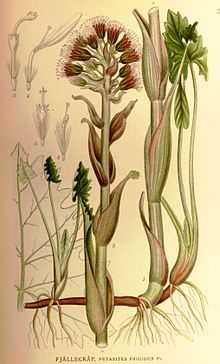Petasites frigidus
| Petasites frigidus | |
|---|---|
| | |
| Arctic Sweet Coltsfoot | |
| Scientific classification | |
| Kingdom: | Plantae |
| (unranked): | Angiosperms |
| (unranked): | Eudicots |
| (unranked): | Asterids |
| Order: | Asterales |
| Family: | Asteraceae |
| Tribe: | Senecioneae |
| Genus: | Petasites |
| Species: | P. frigidus |
| Binomial name | |
| Petasites frigidus (L.) Fr. | |
| Synonyms[1] | |
| |
Petasites frigidus (Arctic butterbur or Arctic sweet coltsfoot) is a species of Petasites native to Arctic to cool temperate regions of the Northern Hemisphere in northern Europe, northern Asia and northern North America.
It is a herbaceous perennial plant producing flowering stems in early spring, and large leaves through the summer. The upright flowering stems are 10–20 cm tall, and bear only 5-12 inflorescences, yellowish-white to pink in colour. The leaves are rounded, 15–20 cm broad, with a deeply cleft base and shallowly lobed margin, and rise directly from the underground rootstock. The underside of the leaves is covered with matted, woolly fuzz. It grows in moist shaded ground, preferring stream banks and seeping ground of cut-banks.

While there is some disagreement, some sources identify five varieties of P. frigidus:
- P. frigidus var. frigidus
- P. frigidus var. nivalis, sometimes referred to as P. nivalis or P. hyperboreus. This variety is common at subalpine and alpine elevations.[2]
- P. frigidus var. palmatus, sometimes referred to as P. palmatus, Palmate Coltsfoot, or Western Coltsfoot; mâl-ē-mē’ (Konkow language);[3] or tä-tä-tē’;[4] pē’-wē is the root.[5]
- P. frigidus var. sagittatus, arrowleaf sweet coltsfoot.
- P. frigidus var. vitifolius[6][7]
Uses
The leaf stalks and flower stems (with flowers) are edible, and can be used as a vegetable dish. A salt-substitute can also be made by drying and then burning the leaves. This black, powdery substance will provide a salty taste.
References
- ↑ "The Plant List".
- ↑ Mathews, Daniel. Cascade-Olympic Natural History. Raven Editions, 1999, p. 186, ISBN 978-0-9620782-0-0
- ↑ Chesnut, Victor King (1902). Plants used by the Indians of Mendocino County, California. Government Printing Office. p. 406. Retrieved 24 August 2012.
- ↑ Chesnut, p. 408
- ↑ Chesnut, p. 407
- ↑ Pojar, Jim; MacKinnon, Andy. Plants of the Pacific Northwest Coast. Lone Pine Publishing, 1994, p. 294, ISBN 978-1-55105-040-9
- ↑ Classification | USDA PLANTS
External links
 Media related to Petasites frigidus at Wikimedia Commons
Media related to Petasites frigidus at Wikimedia Commons Data related to Petasites frigidus at Wikispecies
Data related to Petasites frigidus at Wikispecies